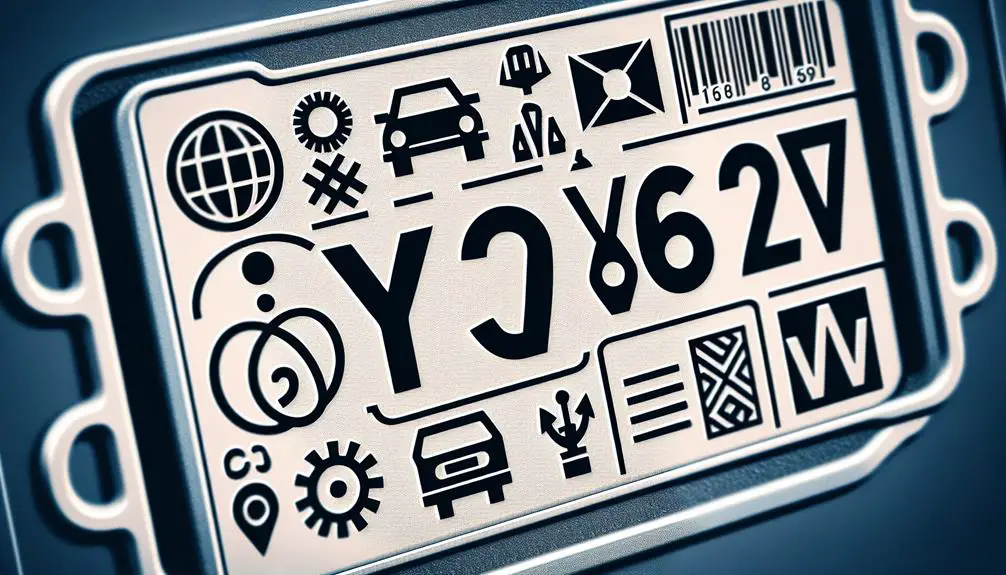Hyundai VIN numbers start with a unique sequence that identifies the car's origin, model, and other important details.
As they say, the devil is in the details, and when it pertains to grasping your Hyundai, it starts with the VIN. You've probably glanced at your vehicle's VIN number, a seemingly random string of characters, without giving it much thought.
However, those initial few characters hold significant information about your car. Hyundai VINs have their unique starting sequences that can tell you a lot about your vehicle, but deciphering them might not be straightforward.
If you're curious about what secrets your car's VIN holds, especially those starting characters, there's plenty to uncover that might surprise you.
Deciphering the VIN Code

Decoding a Hyundai VIN number can reveal valuable information about your vehicle, and it's easier than you might think. Each Hyundai VIN is a unique 17-character identifier that encodes specific details about your car, including its manufacturing country, year, and factory, along with distinctive features, specifications, and its serial number. You're basically revealing a wealth of knowledge with just a series of letters and numbers.
To start deciphering, you don't need any special tools or skills. You can find your Hyundai's VIN on the dashboard on the driver's side, visible through the windshield, or on the driver's side door frame. Once you have it, breaking down the VIN into its component parts allows you to grasp the specifics of your vehicle. This can be incredibly helpful, whether you're verifying the car's history before a purchase, ordering replacement parts, or simply wanting to know more about your car's origins and features.
Hyundai's VIN Explained
Let's now break down the Hyundai VIN, showing you exactly what each segment means for your vehicle. A Vehicle Identification Number (VIN) is a unique code used to identify individual motor vehicles. While the initial few characters are off-limits for this discussion, let's explore the other segments of the VIN and what they reveal about your Hyundai.
| Segment | Description |
|---|---|
| 4th to 8th | These positions provide information about the model, body style, engine type, and transmission of your Hyundai. |
| 9th | This is the check digit, which verifies the authenticity of the VIN. |
| 10th | The model year of your Hyundai is encoded here. |
| 11th | This position identifies the plant where your Hyundai was manufactured. |
| 12th to 17th | These are the sequential production numbers, providing a unique identifier for each vehicle. |
Recognizing your VIN can provide valuable insights into your vehicle's specifications, production details, and its authenticity. While we've skipped the initial characters for now, rest assured, every digit in your Hyundai's VIN has a purpose, contributing to a detailed fingerprint of your vehicle.
The Significance of the First Characters

The initial characters of your Hyundai's VIN hold the key to the vehicle's origin, including the country and manufacturer. These characters aren't just a random string of numbers and letters; they're a code that, when deciphered, can tell you a lot about your car.
The very beginning character reveals the country where your Hyundai was built. This is important for grasping not just the vehicle's geographic origin, but also insights into the manufacturing standards and regulations it adheres to. Following this, the second character identifies the manufacturer, Hyundai, ensuring that you're looking at a vehicle produced by the brand you trust.
Now, the third character, combined with the start two, narrows down the vehicle's type and manufacturing division. This isn't just about whether it's a sedan or an SUV; it's about the specific class and the production line within Hyundai's vast operations.
Understanding these initial characters gives you a clearer picture of your Hyundai's backstory. It's not just a sequence to gloss over; it's a narrative about your car's beginnings, rooted in its very identification number.
Are All Hyundai Vin Numbers the Same Length and Format?
When finding your Hyundai VIN number, it’s important to note that all Hyundai VIN numbers are not the same length and format. Depending on the model and year, the VIN number can vary in length and format. Always check your specific vehicle for accurate information.
How to Interpret Hyundai VINs
Decoding your Hyundai VIN can reveal a wealth of information about your vehicle, including its specifications, history, and authenticity. Each of the 17 characters in your VIN holds specific details about your car, making it a unique identifier. Here's how you can start to comprehend what your VIN says about your Hyundai.
To start with, the initial character indicates the country of manufacture. For example, a Hyundai made in South Korea will have a VIN starting with 'K'. This detail alone can be quite insightful, especially when considering the manufacturing standards and practices of different countries.
When you look further into your VIN, several other aspects of your vehicle come to light:
- Model Year: The 10th character tells you the year your car was manufactured. Each year has a corresponding letter or number, allowing you to pinpoint exactly when your vehicle rolled off the assembly line.
- Plant Code: The 11th character indicates the plant where your Hyundai was assembled. Each manufacturing facility has its unique identifier, shedding light on where exactly your car was built.
- Sequential Number: The last six characters are a unique serial number for your vehicle, distinguishing it from others of the same model and year.
Comprehending your VIN is like accessing a treasure chest of information about your Hyundai. It's not just a series of random characters but a detailed fingerprint of your vehicle's identity.
VIN Variations Across Models

Comprehending how to interpret your Hyundai VIN is just the beginning; now, you'll see how VINs might vary across different models. Each Hyundai model bears unique identifiers within its VIN, making it essential for you to grasp these variations. For instance, the compact Elantra and the mid-size Sonata will have distinct model codes embedded in their VINs, reflecting their category and specifications.
You'll notice that the 10th character in the VIN indicates the vehicle's model year, a universal aspect across all models. However, the characters that denote the plant of manufacture and specific model features can differ significantly. The Tucson and Santa Fe, despite both being SUVs, have different codes for their versions, engine types, and optional packages.
Furthermore, performance models like the Veloster N have unique identifiers compared to their standard counterparts, highlighting their high-performance attributes. Even within the same model, variations such as the hybrid or electric versions carry distinct markers to differentiate them from the conventional gasoline-powered vehicles.
Understanding these variations is essential for accurate vehicle identification, ensuring you get the right parts, services, and history reports. It's all about paying attention to the details that distinguish one Hyundai model from another.
Conclusion
Now you've got the hang of decoding Hyundai VINs. Remember, the initial characters are important, revealing the vehicle's origin and manufacturer. Whether you're checking a Sonata or a Santa Fe, each VIN gives away its unique story.
By comprehending how to interpret these codes, you've opened up a deeper insight into your Hyundai's identity, ensuring you're better informed about its specs and history.
Keep this guide handy, and you'll always know exactly what you're driving.